Want to grow your twitter followers responsibly?
Trusted by 50,000 monthly users • since 2009
These days, "fake news" may feel like a catchphrase or the punchline of a bad joke, but it's a far more serious problem. Fake news is everywhere, and it may be traveling faster than the truth on certain social media platforms.
Studies now show more than 1 in 4 people of voting age visited fake news websites supporting either Hillary Clinton or Donald Trump in the final weeks of the 2016 presidential election. And while the election may have brought attention to the prevalence of fake news, it isn't anywhere close to being quickly identified or easily resolved.
In July 2018, YouTube announced a $25 billion plan to makes fake news more easily detectable on the site, and across the world, Facebook is running full-page ads in an Indian newspaper to help locals recognize the signs of fake news through apps like WhatsApp.
So who's sharing fake news? To find out, we collected fake news articles posted online from June 2017 to June 2018 and analyzed more than 20,000 Twitter followers who shared or retweeted them. Our study covers everything from fake articles about Stephen Hawking and sexual misconduct to claims that Texas might be considered a part of Mexico according to other nations. Keep reading as we take a closer look at the fake news epidemic and the ways your state may be involved in passing along bad intel.
So where exactly did fake news spread between June 2017 and June 2018?
According to the hundreds of stories examined from over 20,000 unique Twitter users, fake news was most often shared in New York. With 12.5 Twitter users sharing fake news per 100,000 residents, the state was responsible for the most fake news shares over the year. Nevada (11.5), Oregon (11.2), and California (9.0) were also among the states that ultimately shared the highest volume of fictitious articles.
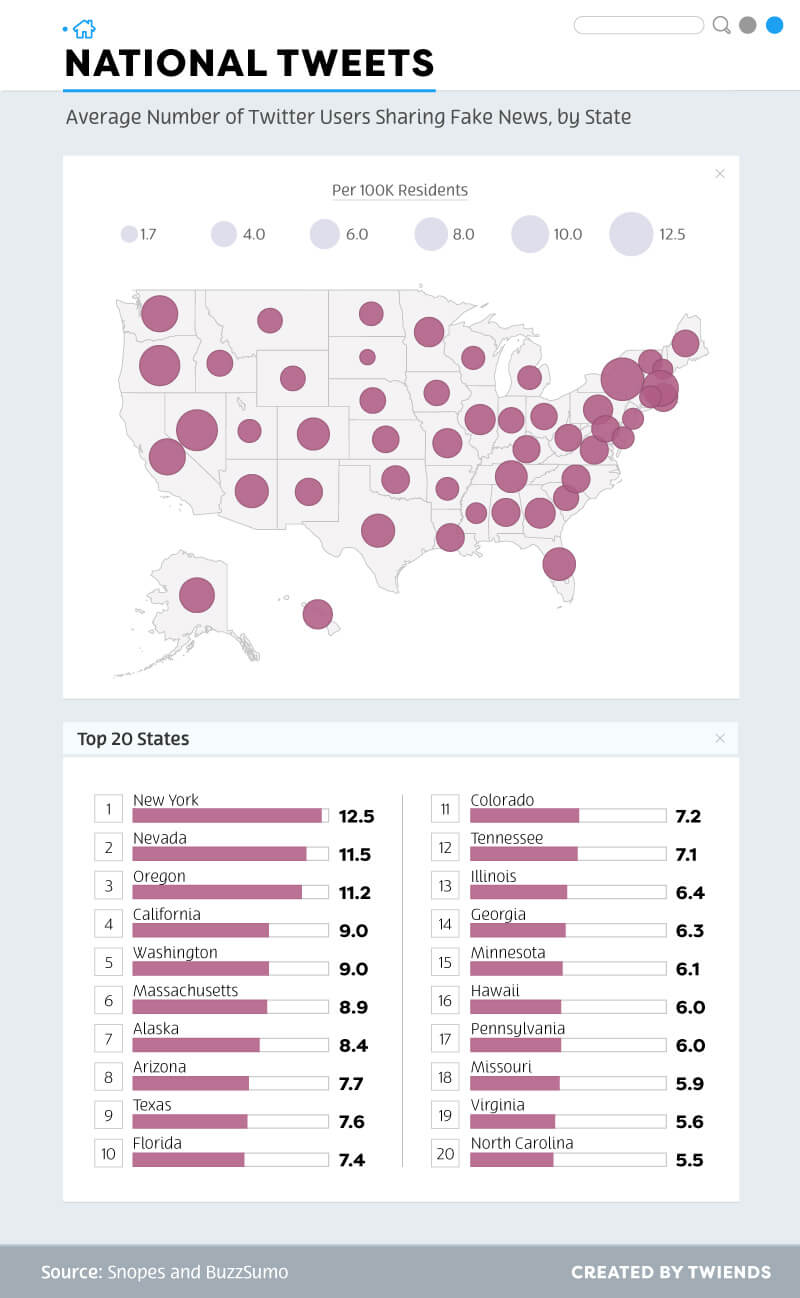
In June 2017, protestors gathered outside of CNN's Atlanta headquarters to rally against "fake news." After months of aggressive tweets from President Trump (and after he awarded the worst in fake news), a Michigan man was arrested in 2018 for threatening to gun down employees at CNN over similar accusations of "misleading" news reports.
Despite potential violence over these allegations of fake news from CNN, it was Twitter users in Atlanta who were the most responsible for spreading fake news articles and falsified headlines. For every 100,000 Atlanta residents, more than 70 Twitter users shared fake news articles over the course of a year.
Outside of Atlanta, it was Twitter users in cities like Pittsburgh, Pennsylvania; Orlando, Florida; Boston, Massachusetts; Portland, Oregon; and Seattle, Washington who were the most responsible for perpetuating fake news and fabricated narratives. Urban areas across America have more access to broadband internet (and information by proxy), but those same allowances could be blurring the lines between fiction and reality.
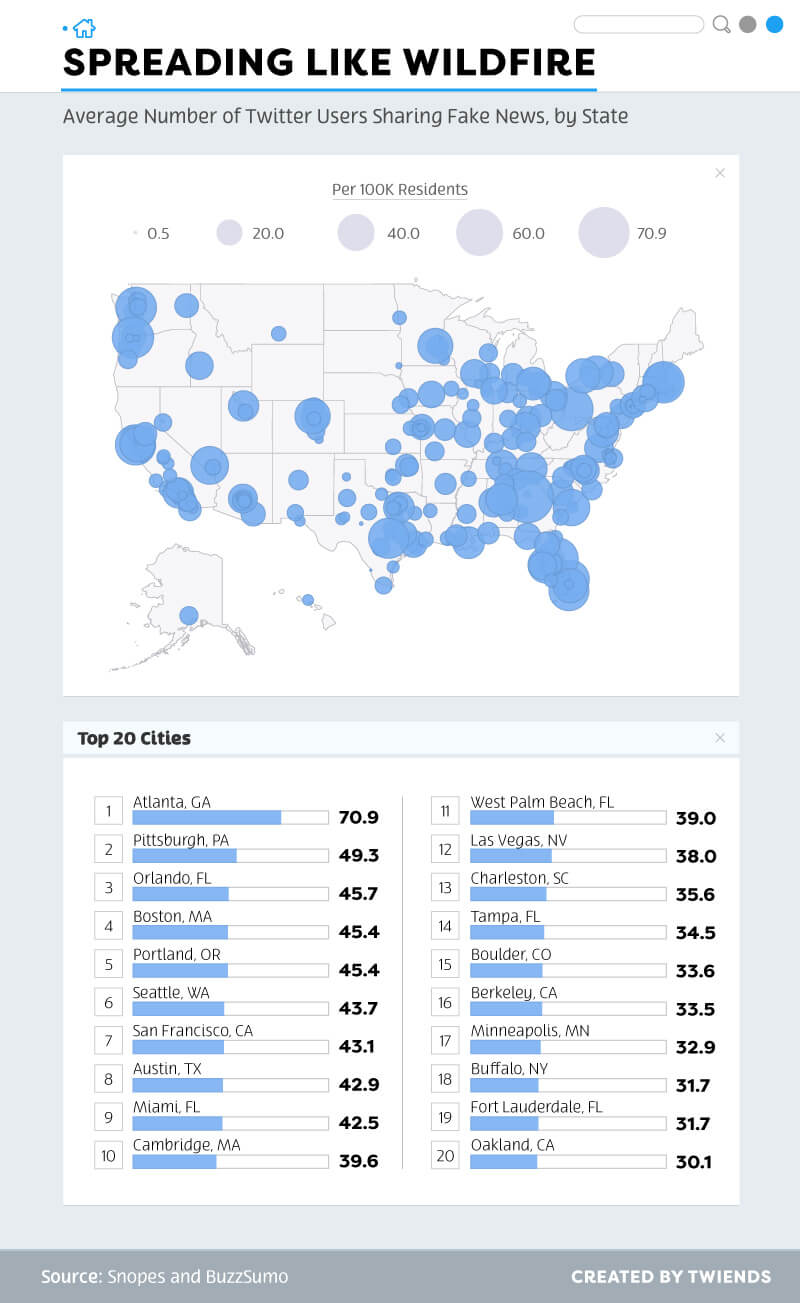
Fake news may have helped manipulate voters during the 2016 presidential election, but those articles may not have been exclusively targeted to help one candidate over another. Because the reach of fake news spread so far leading up to the election, social media users on either side of the political aisle were likely exposed to false narratives and misleading titles meant to shape the opinions of the people reading them.
In the months leading up to the election, the 20 most popular fake news stories earned more shares, reactions, and engagement on social media than the 20 most popular hard news stories during the same time frame. Experts suggest these viral mistruths had a "substantial impact" on the 2016 election.
According to our analysis of hundreds of stories across thousands of Twitter shares, it was left-leaning New York that was responsible for the most fake news shares between June 2017 and June 2018. Nevada (11.5) and Oregon (11.2) were both states that ultimately voted Democratic in the 2016 election and were also responsible for sharing the most misleading posts.
Among Republican-voting states in 2016, fake news was most rampant among Twitter users from Alaska (8.4), Arizona (7.7), and Texas (7.6).
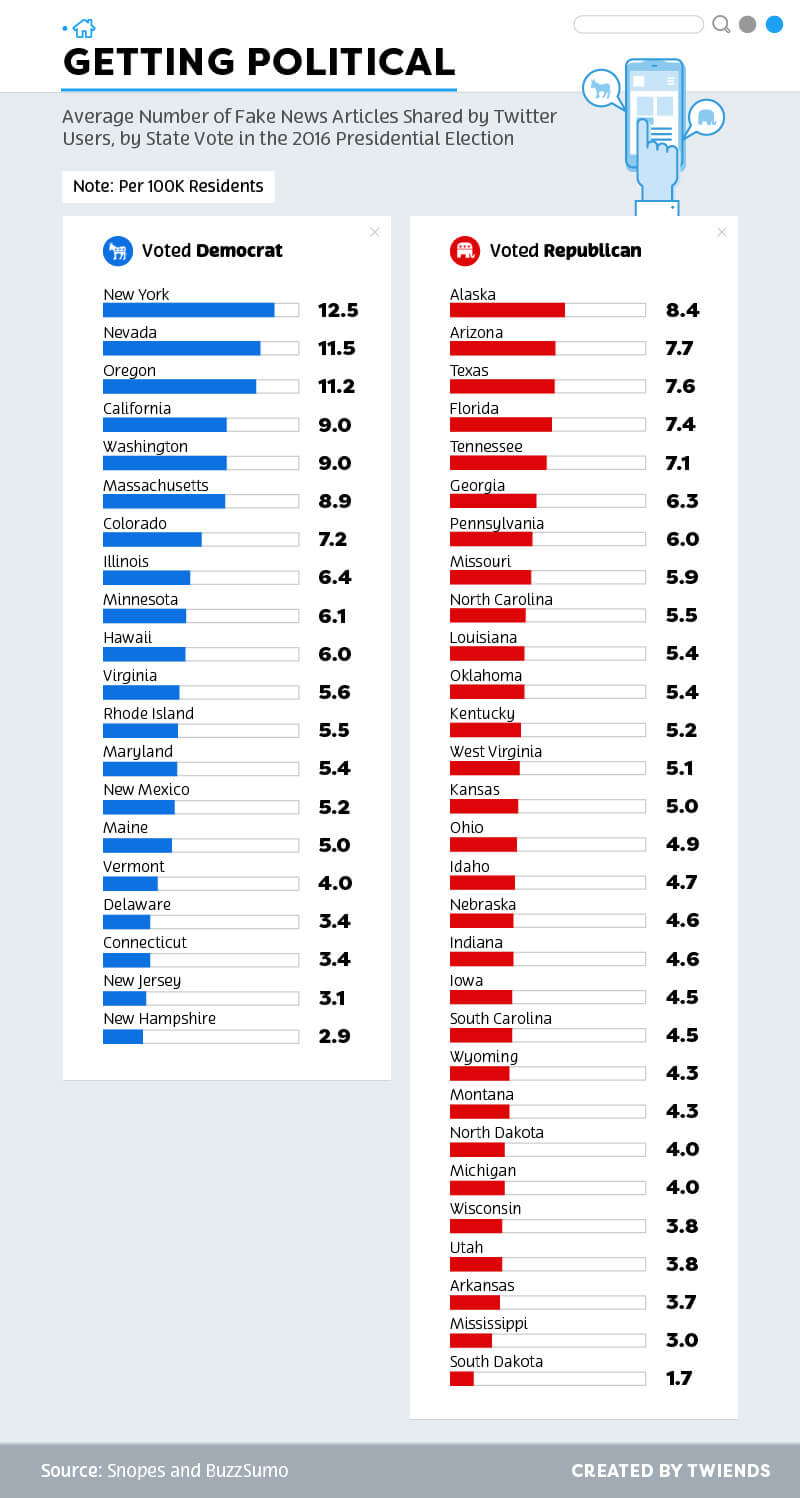
Identifying fake news can be much easier said than done. Even experts struggle to differentiate between legitimate sources and ones that have been fabricated.
In some instances, high-profile political figures with teams of people crafting their speeches or preparing their statements pick up tidbits of information from fake news and disseminate it to larger crowds. In one instance, President Trump incorrectly claimed his State of the Union address drew more viewers than any of his predecessors, and Bernie Sanders wrongly commented on NBC's "Meet the Press" that 40 percent of guns sold in the U.S. didn't include a background check. Despite best efforts, fake news sometimes expertly disguises itself as the real deal, confusing people and politicians alike.
Of the more than 20,000 accounts analyzed, the average Twitter user shared two fake news articles between June 2017 and June 2018. In one instance, a single account shared 11 fake news stories over the same period.
Twitter users in Nevada, a left-leaning state in the 2016 election, shared the most fake news per capita, averaging nearly four articles for every 100,000 residents. Several states, including Alaska, Oregon, New York, and Arizona, shared more than two fake news articles on average.
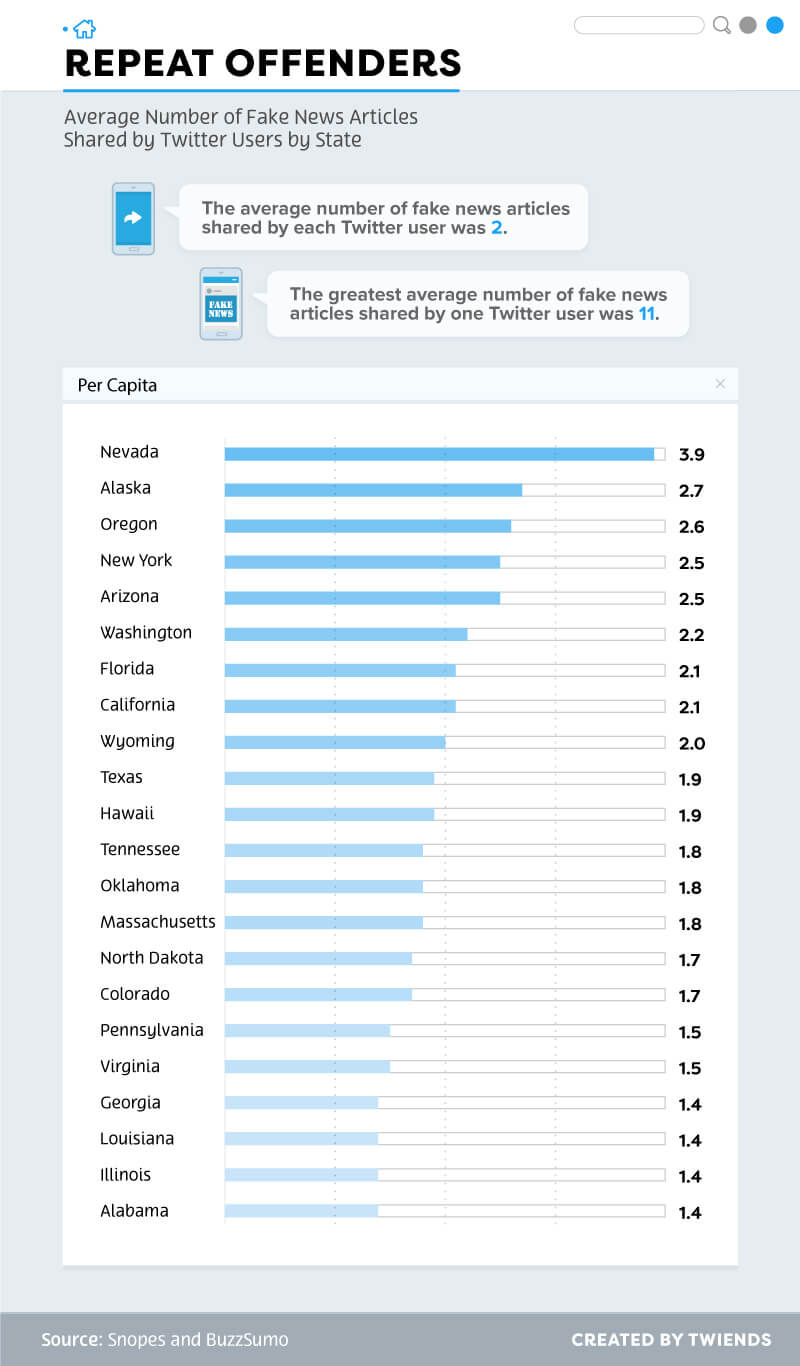
Learning how to spot fake news also means understanding how (and why) the articles crop up in the first place. When a real-life event or person is trending in the news - often followed by hashtags and keywords that help identify them as a popular topic in the news - the fake newsreels start churning. In many cases, these articles are shared by "bots" or artificial intelligence accounts designed to mimic human behavior.
At its core, fake news typically centers on something real. Harvey Weinstein spent months in the hard news cycle due to accusations of sexual misconduct and the #MeToo movement, but not every story about Harvey Weinstein was entirely accurate. Between June 2017 and June 2018, a story titled "Harvey Weinstein Gives Names of Hollywood and Washington, D.C., Pedophiles to FBI?" was the most widely circulated piece of fake news on Twitter. Of the more than 20,000 Twitter accounts analyzed, more than 1 in 4 people recirculated this story despite it being completely fabricated.
Overall, the most popular fake news articles typically involved sex, politics, health care, and environmental issues. Headlines like "Was Stephen Hawking Accused of Sexual Misconduct?" have to be physically clicked on to discern they aren't accurate. In some cases, hundreds and thousands of Twitter users (humans or bots) reshared these stories without validating their authenticity first.
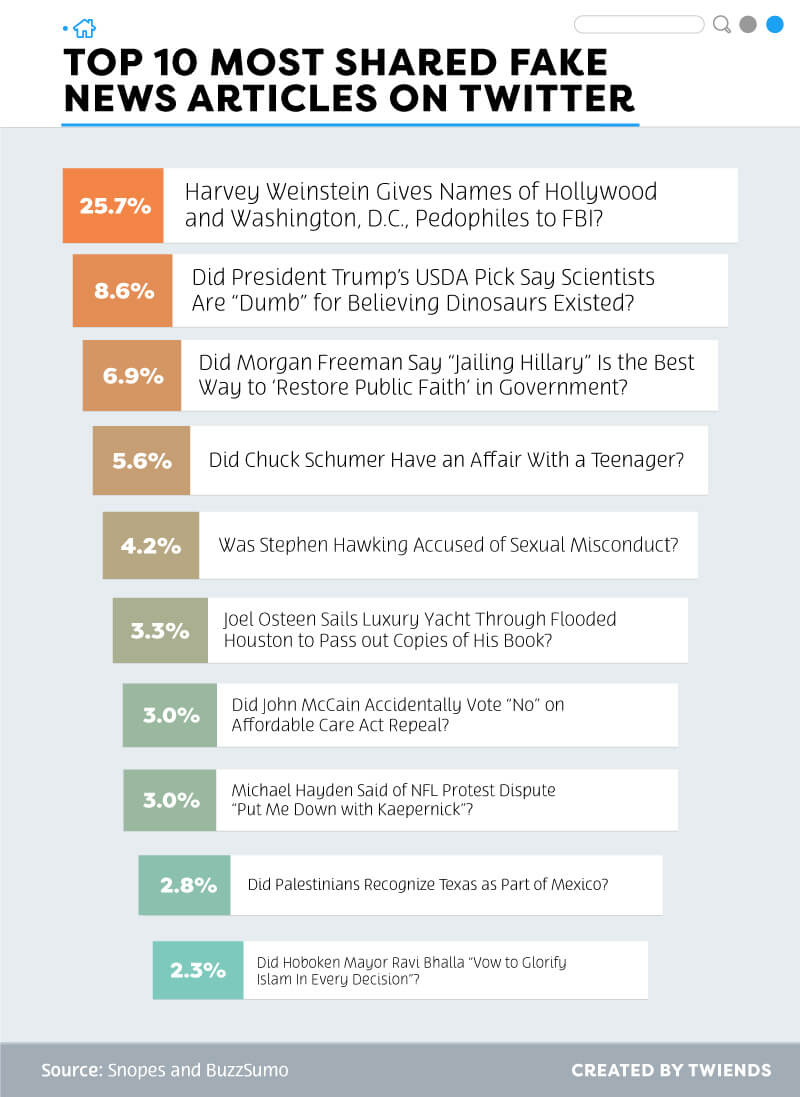
Because fake news article prey on the popularity of real-life issues, it's no surprise that topics like border control and social movements show up as part of the clickbait strategy. What is surprising is how often certain political viewpoints appear as falsified news articles and are shared by unsuspecting users.
On the issue of border control, articles in favor of "building the wall" were just as common as those in favor of open borders. Regarding gun control, fake news was much more politicized. "Gun control" was used nearly four times more often in circulated fake news articles than "2nd Amendment." Like one article insinuating a Democratic congresswoman was introducing a bill to confiscate guns, or another claiming the NRA banned guns at their own forum, these articles appeal to social media users passionate about one side of the argument or another.
Where racial social movements are concerned, "Black Lives Matter" appeared in reshared articles nearly 19 times more often than "White Lives Matter." Regarding abortion rights, "pro-life" was mentioned close to four times more often than "pro-choice."
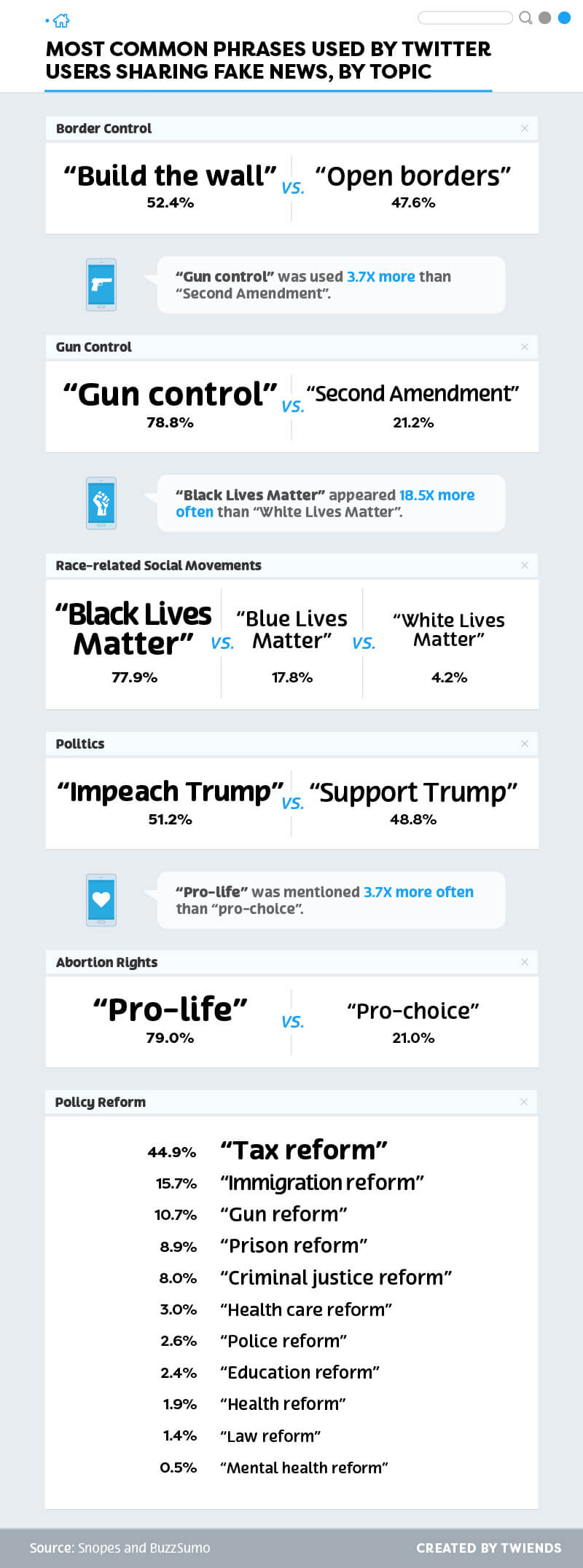
Sprawled across users' social media feeds, or even from the mouths of some of the most powerful politicians, fake news can be dangerous. Because these articles or headlines are often presented in a way that makes them seem credible to readers, discerning between what's real and what's fake on the internet can take some time. Thankfully, there are a couple of ways you can spot fake news in your social media feed.
Experts recommend running URLs through background checks to validate their credibility, taking a closer look at the social media account sharing the content for a clear and obvious bias, and using other search engines to validate authenticity before resharing something. Perhaps most importantly, you should always read beyond the headline to ensure you're getting all of the information before passing along clickbait and buzzwords.
We collected 138 fake news articles from Snopes' Fake News Archive from June 2017 to June 2018. We used the source URL for each fake news article in BuzzSumo to compile a list of Twitter users that shared the articles and then analyzed Twitter users who shared those fake news URLs. We then scraped the latest 3,200 tweets from those Twitter users (20,420 total users and 14.9 million tweets). We used the Twitter API to collect the tweets. See the documentation here. Any Twitter users without a defined geolocation were excluded from analysis. Articles from Snopes where the source of the article couldn't be tracked down were excluded from analysis.
No statistical testing was performed, so the claims listed above are based on means alone. As such, this content is purely exploratory, and future research should approach this topic more rigorously.
While sharing fake news is less than savory, sharing this study isn't. Feel free to share this with your readers for any noncommercial use. We only ask that you include a link back to this page so that our contributors earn credit for their work.